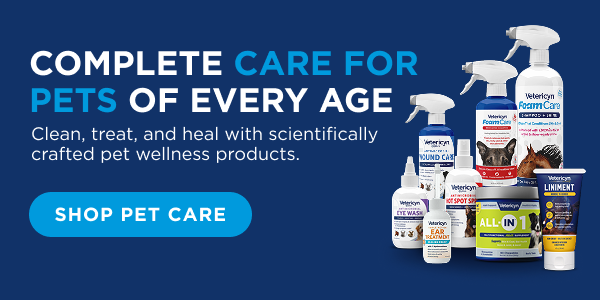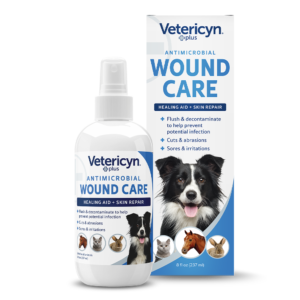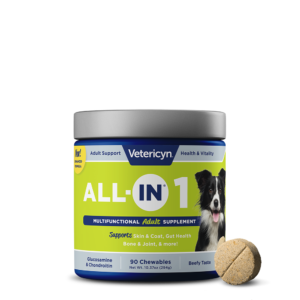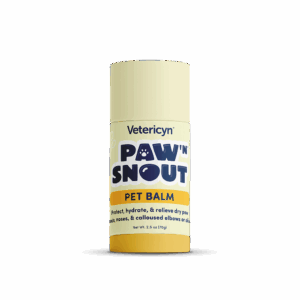Your dog’s nose isn’t just cute—it’s also a huge part of how they experience the world. From sniffing out their favorite toy to tracking every smell on their evening walk, your pup’s nose is constantly at work. But what happens when that once-smooth nose starts to look dry, cracked, or even overgrown with rough tissue? You might be dealing with dog nose hyperkeratosis.
Hyperkeratosis occurs when the body produces too much keratin—the same protein that makes up hair, skin, and nails.1 On a dog’s nose, this extra keratin can build up, creating a crusty, rough, or uneven surface. While it isn’t life-threatening, it can cause discomfort, interfere with your pup’s daily life, and lead to secondary problems if left untreated.
Understanding the symptoms, causes, and available dog care products for nasal hyperkeratosis is key to keeping your dog comfortable.
Symptoms of Dog Nose Hyperkeratosis
Like many conditions, canine hyperkeratosis doesn’t appear overnight—it shows up gradually. At first, you might notice your dog’s nose looking a little drier than usual. Over time, the changes can become more pronounced.
If you suspect your dog may be affected by hyperkeratosis, early detection can give you a head start on managing their condition. Watch for:
Dry, Cracked, or Rough Nose
Change in texture is one of the first signs of dog nose hyperkeratosis. A healthy dog nose is typically smooth and slightly moist, but with nasal hyperkeratosis, the surface can start to look2:
- Dry or flaky, as though the skin is peeling
- Cracked, with visible lines or fissures
- Rough to the touch, losing that typical supple quality
It might seem like a small change, but just think about how often your dog uses their nose—even minor cracks can make everyday sniffing and exploring uncomfortable.
Bumps, Ridges, and Excess Tissue
As keratin continues to build, your dog’s nose may look less smooth and develop uneven textures. You might notice3:
- Raised bumps or ridges forming along the nose
- Layers of excess tissue that look crusty or hardened
- Thickened areas that alter the natural shape of the nose
An overgrown surface can interfere with their ability to take in scents clearly—imagine trying to smell flowers with a stuffy nose. That’s what it’s like when hyperkeratosis makes every sniff just a little more complicated.
Discomfort, Pain, and Secondary Infections
If hyperkeratosis progresses, cracks and fissures may form in the tissue. This is when discomfort really sets in. These openings on the skin can cause2:
- Pain or sensitivity when your dog bumps or rubs their nose
- Bleeding or discharge from deeper fissures
- Increased risk of bacterial or fungal infections in the cracks
Your pup may paw at their nose or rub against surfaces like furniture to find relief. These behaviors can exacerbate irritation, potentially leading to infection if left unattended, similar to how allergies in dogs can drive chronic scratching or licking.
Causes of Dog Nose Hyperkeratosis
So, why does dog nose hyperkeratosis happen in the first place? Hyperkeratosis isn’t always tied to a single clear cause—it can stem from multiple sources, including genetics, age, or other underlying health factors.
Understanding the possible causes can help you and your veterinarian piece together why your dog might be affected.
Genetic Predisposition and Breed-Specific Risks
Some cases of dog nose hyperkeratosis come down to genetics—certain breeds are more prone to developing the condition during their lifetime. Among those most at risk are:
- Labrador Retrievers
- Golden Retrievers
- French Mastiffs
- Cocker Spaniels
In these dogs, excess keratin tends to build up more readily, which means changes to the nose can appear earlier than expected. If you’re a parent to one of these pups, it’s worth keeping an eye on their nose as they age.
Age-Related Development
As dogs grow older, their skin naturally changes. Just as people may develop drier skin over time, senior dogs often experience a buildup of keratin—a nose that was perfectly healthy in puppyhood may slowly develop hyperkeratosis as the years pass.
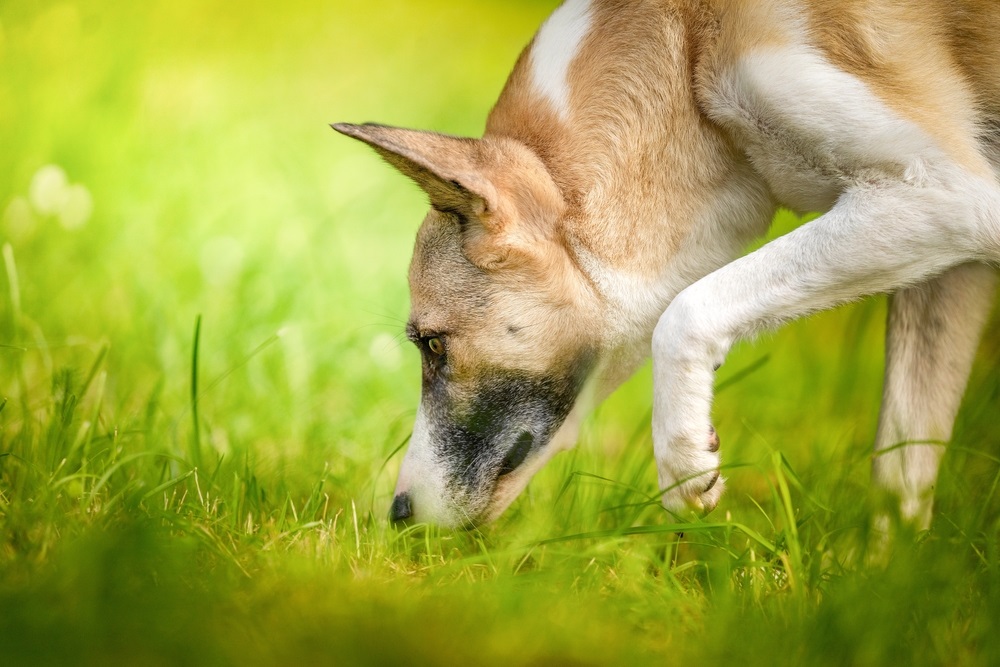
Canine Distemper and Other Viral Causes
Though less common today thanks to vaccines, canine distemper is still a known cause of hyperkeratosis (it can appear in unvaccinated dogs or in areas with outbreaks).3
In dogs who contract the virus, the immune response can sometimes trigger keratin buildup on the nose and paw pads. Other viral infections, such as canine papilloma virus, may also contribute, although distemper is the most recognized link.
See more on why your dog may also be licking its paws excessively.
Zinc Deficiency and Its Role
Nutritional absorption can also play a role. Some breeds—particularly Huskies and Malamutes—have difficulty absorbing zinc properly. Since zinc is critical for healthy skin, a deficiency can lead to conditions like hyperkeratosis.4
Other Contributing Factors
Hyperkeratosis development doesn’t always stick to the predictable patterns of age or breed—it can be a part of your pup’s overall health story instead of a standalone issue.
In these situations, you might see it connected to2:
- Autoimmune conditions that affect skin health
- Allergies that trigger chronic irritation
- Bacterial or fungal infections that exacerbate existing dryness
But no two dogs are alike, so the “why” of dog nose hyperkeratosis can vary from pup to pup. Because there are numerous contributing factors, it’s essential to seek a professional diagnosis before starting any treatment.
Treatment and Management for Dog Nose Hyperkeratosis
While hyperkeratosis can’t be “cured” in the traditional sense, it can be addressed with proper care. The trick is to lean into ongoing management rather than expecting a one-time fix. Fortunately for pet parents, there are plenty of ways to keep your dog comfortable and their nose healthy.
Moisturizing Balms and Ointments
Prioritizing hydration is one of the most essential steps in managing hyperkeratosis. Applying moisturizing balms and ointments to your pup’s nose can1:
- Soften rough or crusty tissue
- Help heal cracked areas
- Create a light barrier against environmental irritants
Be mindful to look for topical treatments that are safe for dogs (especially since most pups will lick their noses right after you apply anything).
Keratolytic Agents and Treatments for Excess Keratin
In some cases, your veterinarian may suggest keratolytic treatments—special products that gently dissolve or break down excessive keratin. Vets usually reserve these treatments for more serious conditions, since they may not be suitable for daily use. However, for these advanced cases, keratolytic agents can reduce thickened tissue and help healthier skin flourish underneath.
Addressing Underlying Causes
If your dog’s hyperkeratosis stems from a zinc deficiency or a past viral infection, your veterinarian may recommend treatments that address the root cause directly. Treatment may involve:
- Nutritional support, like a dog supplement
- Antiviral care
- Other targeted interventions, depending on diagnosis
If an underlying issue is the culprit, managing it can help reduce flare-ups and keep irritation under control.
Importance of Diagnosis
Not all dry or cracked noses are hyperkeratosis. Moreover, not all cases of hyperkeratosis appear the same across different breeds. Rather than guessing, a diagnosis from your vet can help you understand what’s causing your dog’s rough, cracked nose.
Your vet might:
- Rule out more serious conditions
- Identify whether the hyperkeratosis is secondary to other issues
- Create a tailored treatment plan that’s safe and effective for your dog
Even better? Once you know the cause, you can focus on daily care routines and get back to those long, sniff-filled walks around the neighborhood.
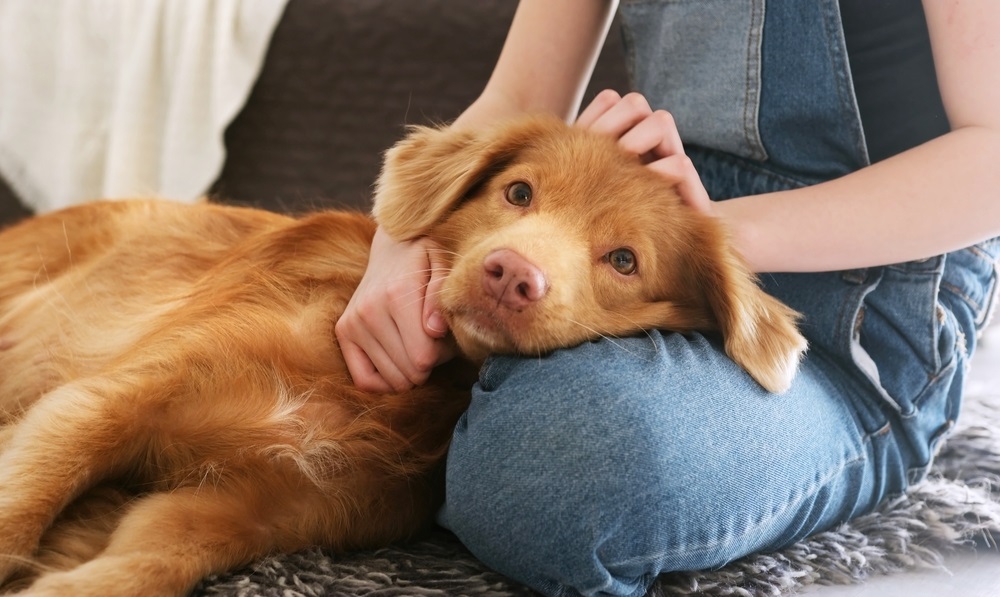
Prevention and Care
While you can’t always prevent hyperkeratosis (especially if it’s linked to genetics or age), you can make a difference in how comfortable your dog feels each day. Small, consistent habits can soothe an already rough nose and keep symptoms from becoming worse over time.
Daily Care Routines for Managing the Condition
Caring for your dog’s nose doesn’t have to be complicated–you can fold it right into the moments you already share: A quick check after walks or while you’re curled up on the couch is often all it takes to know when your dog’s nose needs a little extra care.
Simple ways to work in nose care include:
- Gently cleaning your dog’s nose with a soft, damp cloth
- Checking for new cracks, bleeding, or rough patches during cuddle time
- Regularly applying a high-quality moisturizing balm to keep the tissue supple
Products to Support a Healthy Nose
The products you choose matter when it comes to a healthy nose—especially when you’re supporting a dog with hyperkeratosis.
Vetericyn’s Paw n’ Snout dog nose balm is designed with your dog in mind. This pet-approved solution is formulated to hydrate and help repair the skin without harsh chemicals. They’re safe if licked, gentle on sensitive skin, and easy to incorporate into your daily routine.
When to See a Veterinarian
While you can manage most cases of dog nose hyperkeratosis at home (after a proper diagnosis from your vet), some symptoms may require professional attention. Make an appointment with your vet if you notice:
- Persistent bleeding or open sores
- Strong odor or unusual discharge
- A sudden worsening of crusty tissue
- Obvious signs of pain, like pawing at the nose or avoiding touch
While the vet can be stressful for both pup and parent, a visit when symptoms become severe ensures your pup gets the help it needs fast.
Managing Dog Nose Hyperkeratosis for a Healthier Nose
At first glance, hyperkeratosis may appear to be just a dry nose. However, for most dogs, it can impact their comfort, sense of smell, and overall quality of life. The good news? With consistent care and the right products, dog nose hyperkeratosis is very manageable.
By staying alert to symptoms, understanding the possible causes, and building nose care into your routine, you can keep your pup’s nose healthy and happy.
Vetericyn’s safe pet care products make caring for your pet even easier, giving you one more way to show love for the nose that never stops sniffing out life’s best moments.
 Reviewed by C. Scott Van Winkle
Reviewed by C. Scott Van Winkle
Scott has been with Innovacyn for the past 11 years and has been working within the Burlingame portfolio of companies for the past 23 years. Scott brings a diverse background to Innovacyn. With an upbringing as the 5th generation on his families cattle ranch, Scott has a passion for animal health and the continuous improvement surrounding agricultural practices. Scott earned marketing and business management degrees from the University of Idaho and holds an Executive MBA from Pepperdine University.
Sources:
- National Library of Medicine. Control of canine idiopathic nasal hyperkeratosis with a natural skin restorative balm: a randomized double-blind placebo-controlled study. https://pubmed.ncbi.nlm.nih.gov/29076573/
- Kingsdale Animal Hospital. Hyperkeratosis in Dogs: Symptoms, Causes and Treatments. https://www.kingsdale.com/hyperkeratosis-in-dogs-symptoms-causes-and-treatments
- American Kennel Club. Distemper in Dogs: Signs, Symptoms, Treatments. https://www.akc.org/expert-advice/health/distemper-in-dogs/
- VCA Animal Hospital. Zinc-Responsive Dermatosis in Dogs. https://vcahospitals.com/know-your-pet/zinc-responsive-dermatosis-in-dogs
